Restaurant food cost percentage plays a vital role in determining whether or not a restaurant is profitable. It’s one of your largest variable expenses, and understanding what it is and how to manage it will help you make more net profit on each sale you make.
Chances are you’re reading this because you already knew they were important, but not exactly what they are. Well, if you’re hoping to learn everything about food costs, you’re in the right place.
Sure, driving more orders is great for gross profit, but if you don’t set menu prices to cover all of your fixed, variable, and mixed expenses (and turn a net profit afterwards), your restaurant won’t make enough money to stay in business long term.
Unsurprisingly, food costs eat up a large chunk of a restaurant’s overall budget, along with staff costs and rent. Knowing your food costs inside out is essential for an efficient and profitable restaurant business. Food cost is also the budget line item that is most likely to fluctuate regularly. While staff wages will remain relatively stable, the price of fresh produce can vary from one season to the next. If menu pricing is not done right and carefully monitored according to food cost, your restaurant can quickly run into problems with profitability.
With food cost control you will save money and increase profit.
Here, we’ve put together a guide to explain restaurant food costs, how to set menu prices, turn a profit on each sale you make and run a financially healthy business. And don’t worry if it all sounds complicated, we’ve included some examples that will help clarify everything.
By the time you’re done reading, you’ll know how to find your ideal food cost percentage and set menu prices that guarantee profit:
- How to calculate food cost per serving
- How to calculate food cost percentage
- How to find your ideal food cost percentage
- How to price a menu for profit
- How menu pricing impacts gross sales
- How to lower restaurant food costs
First though, let’s clearly define what are food costs.
What are food costs?
Food costs determine your profitability. Knowing your food costs allows you to properly price your menu.
Food cost is most often shown as a percentage (food cost percentage) and represents the ratio of a restaurant’s total cost of ingredients (food inventory) to the revenue those ingredients generate when they’re sold in the dishes you serve (food sales).

You may be thinking “that sounds like the cost of goods sold (CoGS),” but there is one key difference: while food costs account exclusively for food inventory, CoGS accounts for the total inventory used to prepare a dish, right down to the napkin.
While you could calculate food costs across your whole restaurant, it’s much more effective to look at food costs per serving for setting profitable menu prices.
What are food costs per serving?
Food cost per serving tells you how much one menu item costs to make. To figure that out, you need to know the price of each ingredient, as well as how much you use for the dish.
Food cost per serving formula
To calculate your food cost per menu item, find the sum of the food inventory per serving.
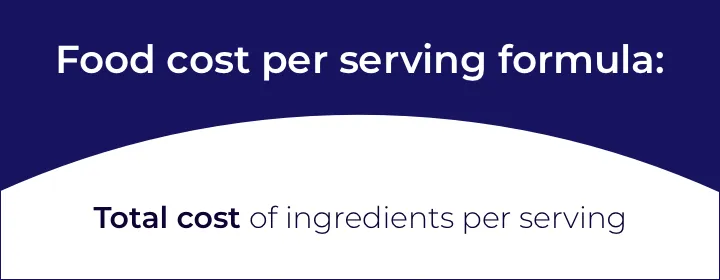
Here’s food cost per serving in an example.
An example of food cost per serving
Let’s say you own a restaurant called Mike’s Pizza Parlor. You want to calculate the food cost per Margherita pizza you make.
To make a Margherita pizza, you need 2 and ¼ teaspoons of instant yeast, 1 tablespoon of sugar, 2 tablespoons of olive oil, ¾ tablespoons of salt, and 3 and ½ cups of all purpose flour to make the dough (approximately 2 pounds per serving). You use ½ cup of tomato sauce and another ½ cup of cheese.
You buy your tomato sauce in bulk at $80 for 4 litres (roughly 16 cups – or 32 pizzas – worth), and calculate that you use $0.93 worth of sauce to make each pizza. Next, do similar calculations for the rest of your ingredients per serving.
- ½ cup of tomato sauce: $2.50
- ½ cup of cheese: $2.03
- 2 lbs of dough: $2.07
Food cost per serving = $2.50 + $2.03 + $2.07 = $6.60
Your total food inventory to make one Margherita pizza costs $6.60.
Now, to set a profitable menu price for that Margherita pizza, you need to know your food cost percentage.
What is food cost percentage?
Food cost percentage is the total value of your food costs shown as a percentage. This is what helps you set menu prices. The trick to turning a profit is to maintain as low of a food cost percentage as possible in relation to the price the dish costs a customer — without sacrificing quality.
This will assure that you have enough gross profit leftover after the sales to pay for all of the expenses that go into running a restaurant.
What is an ideal food cost percentage?
Most restaurant owners and operators try to keep food costs anywhere between 28% and 35% of their total revenue. But in saying that, it’s important to note that there isn’t really such a thing as an ideal food cost percentage.
The truth is that your ideal food cost percentage depends on your restaurant type, the food you serve, your restaurant location, overhead and operating expenses, and other factors. A pizza parlor won’t have the same food cost percentage as a sushi restaurant that uses high-quality (expensive), fresh fish.
We strongly recommend any restaurant owner or operator calculate their own ideal food cost percentage, rather than rely on generalistic ideals. With that said, a general rule of thumb is that the higher your restaurant expenses are (which includes food inventory), the higher your menu prices need to be.
That’s why restaurants with expensive ingredients, a location in the hottest neighborhood, and a beautiful interior design tend to charge more per dish.
How to calculate food cost percentage
Before you can calculate your food cost percentage, you need to find the value of four things: your beginning inventory, your purchases, your ending inventory, and your total food sales.
- Beginning inventory: this is the total monetary value of the inventory you purchase at the start of the week.
- Purchases: this is the total monetary value of the food inventory you buy throughout the week that wasn’t included in your beginning inventory.
- Ending inventory: this is the total monetary value of the inventory left over at the end of the week.
- Total food sales: this is the total monetary value of your weekly sales.
Once you have each of these values you’re ready to calculate food cost percentage.
Food cost percentage formula
To find food cost percentage, start by finding the sum of your beginning inventory and purchases, and subtract the value of ending inventory from the total. Next, divide the result into your total food sales.
Put into a neat formula, it looks like this:
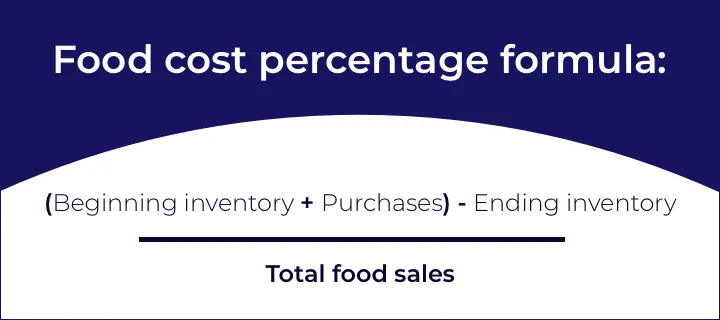
An example of calculating food cost percentage
Let’s see how Mike’s Pizza Parlor would calculate food cost assuming the values below.
- Beginning inventory: $15,000
- Purchases: $9,000
- Ending inventory: $17,000
- Total food sales: $13,000
With the above as his values, Mike would find his current food cost percentage like this:
Food cost percentage = (15,000 + 9,000) – 17,000 / 13,000
Food cost percentage = 24,000 – 17,000 / 13,000
Food cost percentage = 7,000 / 13,000
Food cost percentage = 0.53, or 53%
Mike’s Pizza Parlor’s food cost percentage is a whopping 53%, which means that 53% of their revenue goes towards paying for their food inventory. That’s way above industry averages and dramatically cuts into his profits.
Now, Mike knows that 53% is too high, but he doesn’t know what his food cost percentage should be. To find out, he sets out to find his ideal food cost percentage.
How to calculate your ideal food cost percentage
Before you can find your ideal food cost percentage, you must first find these two values:
- Total food costs
- Total food sales
Let’s say Mike’s total food costs were $5,000. Mike already knows that his total food sales are $13,000. Now, he can use this formula to find his ideal food cost percentage.
Ideal food cost formula
To find your ideal food cost percentage, you need to divide your total food cost into your total food sales. In a formula, that looks like this:
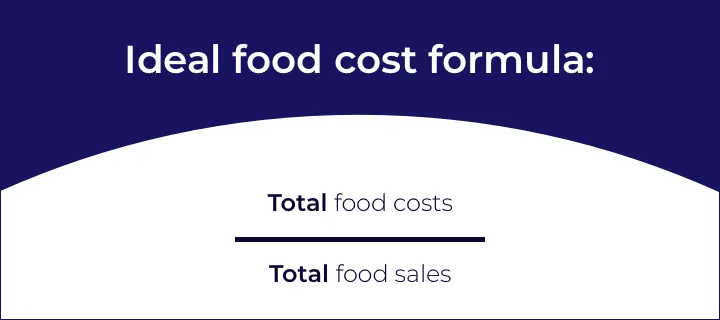
An example of calculating ideal food cost percentage
Using the values from the above example, Mike would calculate his ideal food cost percentage like this:
Ideal food cost percentage = $5,000 / $13,000
Ideal food cost percentage =0.38, or 38%
Based on his calculations, Mike’s ideal food cost percentage is 38%. Considering his current food cost percentage is 53%, he knows he has his work cut out for him. If he gets this right, he can keep 15% more on each sale.
To lower his food costs by roughly 15%, Mike can do one of three (or all three!) things:
- Reduce portion sizes
- Adjust menu prices
- Source cheaper vendors
Mike isn’t willing to buy cheaper ingredients or change vendors. His customers expect premium quality pizzas, and his current vendors source the best quality ingredients in his area.
He also doesn’t want to reduce portion sizes, since he’s concerned customers won’t be happy with that decision.
With that, Mike chooses to adjust his menu prices.
How to set menu prices that turn a net profit
Based on our calculations above, it costs Mike’s Pizza Parlor $6.60 to make one Margherita pizza and their food cost percentage is 53%. That means the menu price of one Margherita pizza is $12.45.
But what does a Margherita pizza’s menu price need to be to bring Mike’s food cost percentage down to a reasonable 38%?
Ideal menu item price formula
To find out, Mike needs to divide cost per serving into his ideal food cost percentage like this:
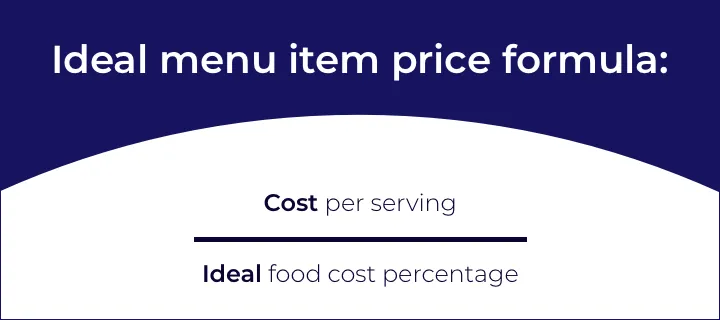
Ideal menu item price = 6.60 / 0.38
Ideal menu item price = 17.36
If Mike’s calculations are correct, he needs to increase the menu price of his Margherita pizza to $17.36, a total increase of $4.91.
Now, you might be thinking to yourself “$4.91 doesn’t seem like much,” but that profit adds up. If Mike sells 100 Margherita pizzas a day, that’s an extra $179,215 in revenue per year.
And that’s from optimizing the food cost to menu price ratio of just one menu item! Imagine if Mike followed the same exercise for his entire menu.
With that, Mike sets his Margherita pizza’s menu price to $17.36. When you increase menu prices, though, it’s important to keep tabs on how the fluctuation in price affects your sales.
2 ways menu prices can affect sales
Part of running a successful restaurant operation is routinely keeping an eye on your menu prices, food costs, other expenses, and total sales. Most restaurants' CoGS fluctuates based on seasonality, and you need to make ongoing adjustments to your menu prices as those costs fluctuate.
When Mike increased the price of his Margherita pizza to $17.36, there are one of two scenarios that could happen:
Scenario 1: Increasing menu prices lowers total sales volume
Let’s say that after he increased its price by nearly $5.00, Mike saw total sales of Margherita pizzas slow down.
That could mean that his new menu price is simply too expensive for customers — they don’t think his Margherita pizza is worth $17.36 and, as a result, they satiate their pizza cravings elsewhere.

If this is the case, then Mike needs to find an alternative to lowering his Margherita pizza’s food cost. Rather than boosting the menu price, he can explore partnering with vendors who carry less expensive produce, using less expensive ingredients altogether, or reducing his portion sizes.
Scenario 2: Increasing menu prices doesn’t slow down sales
Let’s say Mike's Margherita pizza continues to show strong sales figures after he increases its menu price.
Now, Mike could take that as a signal that his customers could afford another price bump. But that can also be a slippery slope.
You want to price your menu item high enough that you turn a strong profit, but not so high that you lose overall sales volume. It’s a delicate balance.
8 tips to lower restaurant food costs
Continuing on the point above, there are a few ways to lower restaurant food costs. With some smart menu engineering, you can update menu items that are no longer profitable. Here are three ways to lower your food cost per serving:
Serve smaller portion sizes
Mike could reduce the size of his Margherita pizza from 14 inches (approximately 10 slices) to 12 inches (approximately 8 slices). Using fewer ingredients results in lower food costs per serving.
Don’t overuse ingredients
In the heat of service, it’s easy for a cook to use ingredients perhaps too liberally. Along with serving smaller portion sizes, consider methodically documenting how much of each ingredient goes into each meal on your menu.
Train your back-of-house staff to use only as much of each ingredient as you plan into the recipe. This can help you stretch your food inventory further without compromising taste or quality.
Use less expensive ingredients
This is often a restaurateur’s last resort — use cheaper ingredients at your own risk. If customers notice your restaurant’s food quality is going down, they may take their business elsewhere. That being said, if you strategically use cheaper ingredients, it can be a viable way to lower food cost per serving.
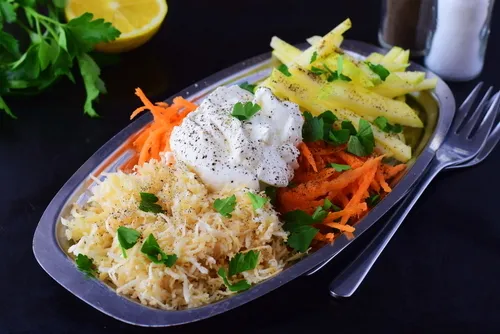
Partner with cheaper vendors
Perhaps it’s time to explore other vendors with similar quality ingredients, but lower costs. Alternatively, you can consider working out a deal with your existing vendor. Some may be willing to give you a discount for purchasing in bulk or signing a long-term agreement.
Negotiate pricing with your current vendors
Alternatively, you can consider working out a deal with your existing vendors. Some may be willing to give you a discount for purchasing in bulk or signing a long-term agreement.
Can’t buy bulk? Partner with restaurants in your area
For establishments with a high sell-through rate, purchasing in bulk is a viable option. But for many other establishments, they may not be able to sell their bulk food inventory before it spoils.
If purchasing in bulk isn’t a viable option for your establishment, consider partnering with other restaurants in your area and purchasing in bulk from the same vendor as a group.
The advantages of this approach are numerous. For starters, you get the benefit of lower costs without the associated price tag. Additionally, you are proactively preventing incurring a sunken cost in the form of spoiled food inventory that cannot be salvaged. Finally, you build an alliance with your contemporaries, which can lead to fruitful partnerships and collaborations in the future.
Purchase seasonal, local produce
It goes without saying that in-season produce is typically less expensive than ingredients sourced from elsewhere. If you haven’t already, consider changing your menu regularly and featuring dishes that use locally sourced, seasonal ingredients.
Not only does this help you cut down on food costs, but it can help differentiate your restaurant from others. Consumers (particularly travellers) love to experience a culture through its cuisine, and by serving local ingredients, you’re giving them an opportunity to sample tastes that reflect your region.
Not to mention, by supporting local farmers and producers, you’re helping stimulate your local economy. Seems like a win/win to us!
Use food ingredients strategically
If you aren’t using your ingredients across multiple dishes, you’re missing an opportunity to stretch your food inventory further. Let’s say Mike bought too many tomatoes and, based on his forecasts, he doesn’t think he’ll be able to use it all before it spoils.
Mike could repurpose those tomatoes and add gazpacho, or a tomato and goat cheese salad, to his menu. Always consider using your food ingredients in several menu items. When done correctly, it lowers the different types of food you purchase at the beginning of each week, which, in turn, lowers your food costs.
Your guide to managing restaurant food costs
Whew, you made it!
Managing restaurant food costs is a lot of work, but controlling the percentage of revenue that goes towards paying for food inventory is an essential balancing act that helps you make more gross profit on each sale (which means more money in your pocket after you deduct all business expenses).
Once you set menu prices, you can assure those adjustments are reflected in your online ordering platform and start reaping the financial benefits of your efforts.


